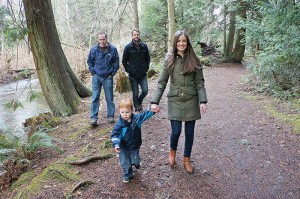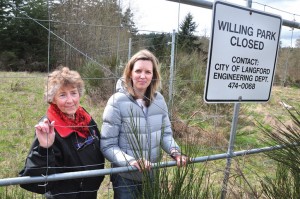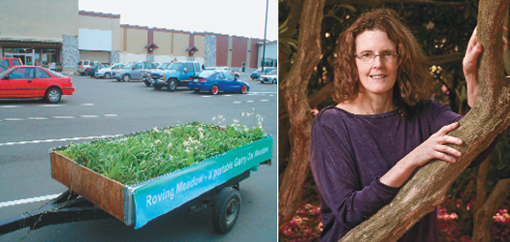Farmland freeze needed now
G.E.Mortimore
From the Lower Island News, April/May 2010
B.C.’s Agricultural Land Commission has a moral duty to guard and improve the food supply. So why do the commissioners shirk their duty?
The law allows removal of pieces of land from the Agricultural Land Reserve (ALR) for well-documented reasons, but its main purpose requires commissioners to safeguard food-producing capacity and encourage farming.
Commissioners ignore that order. They let builders pave over big chunks of foodland. The loss of land has become so painfully obvious, and the need for nailing down a close-to-home food-supply system in a changing world has become so urgent, that the commissioners now have only one honourable and practical choice: To freeze all applications for removal of land from the ALR province-wide, until food-growing policy is sorted out by a public enquiry and action plan. A three-year brainstorm-break seems reasonable.
Between 1975 and 2003 the commissioners approved a net decrease of 35,500 hectares, 87,720 acres, in the reserve farmland of the Okanagan, the Fraser Valley and Vancouver Island. On the Island alone, the decrease was 12,797 hectares.
In the part of B.C. where most of the people are concentrated, the shrinkage of foodland has continued at a fast rate since 2003, and a thick file of convoluted arguments for ALR removal, couched in planning jargon, has accumulated in Langford, Cowichan and other Island places.
It’s time for commissioners to stand tall and really do their protective job, rather than just pretending to do it – a pretence that involves surrender to Premier Gordon Campbell. The Campbell government weakened the protection of foodland by splitting the commission into six regional agencies, each with the independent power to say yes or no to applications for removal.
The old province-wide solid group of land judges, or quasi-judges, stemmed the loss of prime farmland, which was bleeding away at 6,000 hectares a year when the Dave Barrett NDP government created the ALR in 1973. Premier Campbell sliced open six arteries and started the bleeding again.
Governments of all colours share some guilt for this disaster. “Liberals,” Socreds and NDP have all intervened at the top level, to curry favour with pave-it-over campaigners. But Premier Campbell, the present culprit, is the worst offender. His fragmented panels, which meet separately and do not consider removal applications as a united body, have shown how vulnerable they are to pressure from municipal councils and land-speculator/developer lobbyists.
Arguably the lobbyists could make more money if they waited and thought longer, resisted sprawl which causes long-term expense to taxpayers, and concentrated development in high-density mixed-use nodes where big buildings could be insulated by rooftop gardens. Developers and land speculators are impatient, but it’s the job of the ALC to cool and re-direct the natural quick-money impulse. The scattered ALC tribunals should now join in a united front to support the long-term provincial interest, which takes account of great-grandchildren as well as contemporary yearners for wealth and comfort.
Might commissioners be politically punished for doing their job too well? They have little to fear. Arm’s-length agencies now have power to shame governments if they commit blunders, arrogances and sneaky tricks. Auditor-General John Doyle skewered Campbell and colleagues for violating the public interest when they gifted a forest corporation with millions in taxpayers’ money and trashed land-use and forest-conservation planning on a large tract of southwestern Vancouver Island. Foodland guardians who show quiet courage are unlikely to get even a slap on the wrist from a government that seems headed for lame-duck status despite the long distance to next election.
“Food security” is a great slogan. It means growing food close to home. But unless we match actions to words, mouthing the slogan is a waste of breath. We need that three-year freeze on ALR removals, so we can feel our way into the evolving city-green design.
It isn’t just about commercial farms. Current eco-pressures – looming hikes in the cost of oil-driven long-distance food transport, climate change, economic hard times, numbers of fat couch-potato kids – challenge land commissioners and all of us to brainstorm varied food-production patterns.
These range from high-intensity urban organic farms to rooftop vegetable beds above shoppping-mall/condo complexes, and networks of neighbourhood gardens protected within the ALR.
Healthful food for two daughters was among Michelle Obama’s reasons for planting a vegetable garden on the South Lawn of the White House. This rerun of Eleanor Roosevelt’s 1943 Victory Garden was partly driven by Mrs. Obama’s experience as a working mother when she sought a nourishing menu for Malia and Sasha, Marian Burros reported in The New York Times.
“Eating out three times a week, ordering a pizza, having a sandwich for dinner all took their toll in added weight on the girls, whose pediatrician told Mrs. Obama that she needed to be thinking about nutrition.” Within months the girls shed weight.
Twenty-three fifth-graders from a nearby school will cultivate the garden, alongside the Obamas. The U.S. president will pull weeds. Sure, he has other things to do, but he needs his exercise.
Derelict car factories and abandoned houses and yards in the downsized automobile city of Detroit will be converted into mushroom sheds and urban farmland.
Hantz Farms will plant crops on 5,000 acres within Detroit’s city limits. The greening of Motown is one of many true stories about today’s trend toward growing food close to home.
City-green is maturing into a mainstream political force. Does this mean strong, decisive action, or gradual change in food habits, one family at a time? Both. One won’t work without the other.
We need to add to the ALR, not reduce it. Soil quality is not crucial. Refugees on the Aran Islands off Ireland’s West Coast made soil for crops and pasture by laying sand and seaweed on solid rock. Greenhouses and roof gardens must import soil. Roof gardens insulate buildings, conserve runoff rainwater, and reduce air pollution and energy costs.
Chicago has 2,500,000 square feet of green roofs, more than any other U.S. city. The green starts with a demonstration garden on the roof of Chicago City Hall. The city makes grants of $5,000 toward roof-gardens.
We need urban space dedicated to food-growing, from roof gardens to community garden-patches and plantations and orchards that supply food banks; and we need a political mindset that encourages such projects.
The rescue of 9.3 acres of endangered Saanich ALR food-land is a success story in the struggle to protect the food-production system from raids.
In 2001 the Capital Regional District, the owner of the Haliburton Road land, was going to push its removal from the reserve and sell it for building 24 to 26 houses; but the Land for Food Coalition and the Cordova Bay Association for Community Affairs persuaded Saanich to buy the tract for $400,000. and keep it green, with side-by-side commercial farms, gardening and cooking school and community organic farm staffed partly by volunteers.
A more loose-jointed but equally valid agricultural model is under threat in Happy Valley and Luxton, in the Victoria suburb of Langford, where developers have filed applications to take a number of food-land tracts out of the reserve and build hundreds of houses, hived away from a diminished array of food producers by “edge planning,” the currently fashionable Plannerspeak phrase.
Luxton Fair and Luxton Market are the show-windows for growers of herbs, garlic, tomatoes, strawberries and other crops in a district of mingled cottages, old farmhouses and horse barns – territory where a person used to be able to live in a garage while he built his dream-house.
Can this federation of small growers survive invasion by massed housing? ALC commissioners need the three-year time-out to find an honest answer.
Some people trust Langford city council to be the guardian that will purchase ALR farmland and keep it green, as Saanich municipality did for the Haliburton land. Hostile critics object that in view of Langford’s pro-development record, such a move would be equivalent to putting the fox in charge oi the henhouse.
This point can be argued out. If the commissioners observe a three-year freeze on ALR withdrawals, however, the argument won’t matter.
The current commissioners who will hear applications for removal of Island lands from the ALR, Lorne Seitz of the Okanagan, Jennifer Dyson of the Alberni Valley and Niels Erik Holbek of Black Creek, are all commercial farmers. Their background may incline them to judge ALR land on a narrow conventional-farm basis, and to regard municipal councils (some of whom were elected by less than 25 per cent of eligible voters) as representing public consensus.
Both these ideas are outdated. The public and the commissioners would benefit if people urged the commissioners by snail-mail to reconsider their approach. Why not look them up and give direct persuasion a try? Making a pitch through the commission’s office has proved itself to be mostly a waste of time. -30-
Both these ideas are outdated. The public and the commissioners would
benefit if people urged the commissioners by snail-mail to reconsider their
approach. Why not look them up and give direct persuasion a try? Making a
pitch through the commission’s office has proved itself to be mostly a waste
of time.
-30-
G.E. Mortimore, Ph.D., is a writer and social anthropologist based in
Victoria. Portions of this article have previously apperared as comment columns in
The Goldstream News Gazette.


